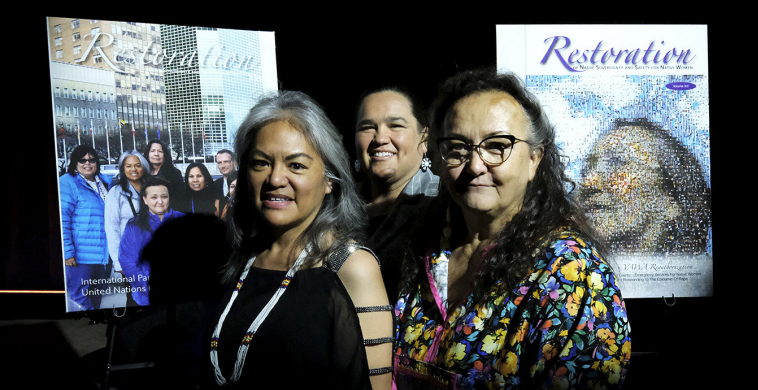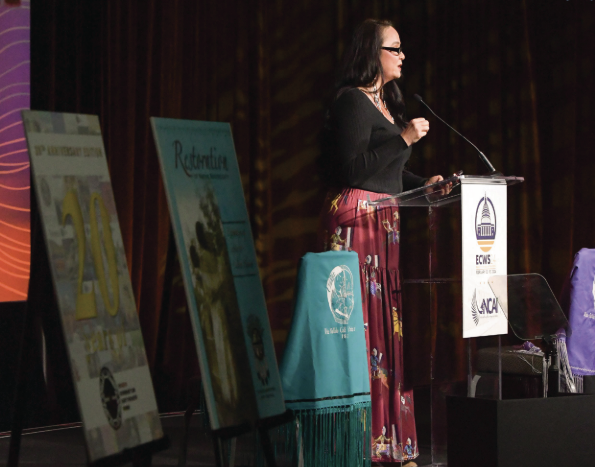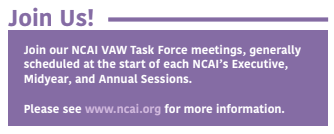Joint NIWRC and NCAI Reception
Celebrating 20 Years of the Restoration Magazine and Honoring the Leadership of the NCAI VAW Task Force

On February 12, the National Indigenous Women’s Resource Center (NIWRC) and the National Congress of American Indians (NCAI) hosted a reception celebrating 20 years of Restoration of Native Sovereignty and Safety for Native Women Magazine (Restoration) and honoring the past and present leadership of the NCAI Violence Against Women Task Force. Excerpts from the speakers are included below.
Restoration Magazine was launched 20 years ago and echoes the voices of advocates, survivors, families, Tribal leaders, and communities—our Tribal groundswell—who called for the inclusion of what was eventually called the Safety for Indian Women title in the 2005 Violence Against Women Act (VAWA) bill. With each reauthorization of VAWA since 2005, in 2013, and 2022, our Tribal groundswell, in alliance with our non-Tribal groundswell, has succeeded in what seemed impossible.
Restoration, now a publication of NIWRC, has become an essential tool in the movement to protect and promote Tribal sovereignty and increase safety for Native women. We are thankful for the hard work, vision, and insight of everyone who has contributed to, read, and shared Restoration over the past two decades.
Founded in 2003, the NCAI VAW Task Force provides a space for advocates, Tribal Coalitions and organizations, and Tribal leaders to organize to ensure that ending violence against women is a priority for Tribal Nations. Thanks to the work of past Task Force leadership, dedicated members, and our current co-chairs, Juana Majel Dixon (Pauma Band of Luiseño Indians) and Shannon Holsey (Stockbridge-Munsee Community Band of Mohican Indians), we have made monumental strides in our mission for safety and sovereignty.
Excerpted Speaker Remarks
NCAI Board President Mark Macarro (Pechanga Band of Indians):
“On November 17, 2000, in St. Paul, Minnesota, the National Congress of American Indians passed a resolution establishing the Violence Against Women Task Force.
“It reads, ‘WHEREAS, it is necessary for NCAI as the leadership for tribal governments to be proactive in defense of Native women to curtail and prevent violence against Native women; WHEREAS the future of indigenous nations rests in the secure status of women, to live in an environment free of violence.’
“Three years later, nonprofit Tribal domestic violence and sexual assault coalitions partnered to breathe life into this resolution. The NCAI Violence Against Women Task Force was born.
“That same year, the Restoration Magazine was launched. The creation of the magazine coincided with the campaign for the Violence Against Women Act of 2005. [We] recognized that for Tribal leaders, advocates, and Tribal communities to fully participate in the movement, they needed continuous political briefings on issues impacting the safety of Native women and emerging legislation. Article by article, the Magazine provided the analysis required to make systemic reforms. It outlined initiatives and goals in the struggle of resistance, which continues today.
“For twenty years, the Task Force has convened at each NCAI conference. For twenty years, its members have worked tirelessly to protect Native women and to ensure the sovereign rights of Tribal Nations to protect their own people. For twenty years, advocates and allies have been putting their stories on paper. For twenty years, the people in this room– and many others– have refused to stay silent.
“Twenty years ago, the maximum sentence a Tribe could issue for convicted felonies was one year of imprisonment and a $5,000 fine. Only 4% of VAWA funds were dedicated to Tribal Nations. The state of Alaska was largely ignored by VAWA despite having the highest rates of violence of any state in the country. Sex trafficking was not yet outlined as a purpose area for tribal grants. The inherent Special Tribal Criminal Jurisdiction of Tribes had not yet been affirmed over non-Indians committing domestic violence on tribal lands. Because of the policy gains of the last twenty years, Native women are safer. Tribal sovereignty is stronger.
“And yet jurisdictional gaps remain. Native women experience violence at higher rates than any other demographic. The epidemic of murdered and missing indigenous women continues to be a crisis exacerbated by threats like man camps on tribal lands and the removal of resources from Indian Country in the wake of the Castro-Huerta decision.
“Public safety continues to be a leading concern of tribal leaders. Our work is not done until all victims in Indian Country have access to the life-saving provisions of VAWA. We gather here not just to celebrate but to reenergize and reinvigorate.
“Congress must take action to remove the gaps in tribal jurisdiction, provide resources for exercising that jurisdiction, improve tribal access to federal criminal databases, respond to the need for a thorough criminal investigation of every case for the murdered and missing, address the unique challenges in Alaska, and ensure there are resources available for victim services. Domestic violence, sexual assault, stalking, and trafficking will not be tolerated on tribal lands. Our work is not done.”
NIWRC Board Vice Chairwoman Carmen O’Leary (Cheyenne River Sioux Tribe):
“Over the past 20 years, the Restoration Magazine has served as a primer on violence against Native women, including assisting Tribal Governments with their testimonies for the annual USDOJ Tribal Consultation on VAWA. Communication is necessary to get our needs met.
“Over the years, Restoration has contributed to providing analysis to make systemic reforms and working with the national movement to create changes to federal laws, policies, programs, and practices. Communicating our realities through the Magazine has helped to inform and inspire grassroots organizations to:
- Prioritize restoring local Indigenous protections rooted in Tribal voices, languages, and teachings, and
- Exercise Tribal sovereign authority to inform, engage, and advocate for transforming federal responses and removing systemic barriers. Such an exercise helps to hold the U.S. government accountable for fulfilling the federal trust responsibility to assist Tribal Governments in safeguarding the lives of Native women.
“As Indigenous women, we understand that we form the backbone and lifeblood of our Nations. Hence, the Cheyenne quote on the back of Restoration: ‘A Nation is not conquered until the hearts of its women are on the ground. Then it is finished, no matter how brave its warriors or how strong its weapons.’
“Restoration is a publication dedicated to informing Tribal leadership, Governments, and communities, as well as federal, state, and international leadership, of issues impacting the safety of American Indian and Alaska Native women. The name of the Magazine reflects the grassroots strategy of the NCAI Violence Against Women Task Force that by strengthening the sovereignty of Indian Nations to hold perpetrators accountable, the safety of Native women will be restored.
“We look forward to our strong-hearted partnerships with NCAI, our contributors, Tribal Coalitions, and allies. Join us as we continue to discuss strategic questions in the struggle for survival, deepening and expanding how we rebuild American Indian, Alaska Native, and Native Hawaiian Nations. As our beloved sister and friend Tillie Black Bear would say, join us in resistance.”
NIWRC Board Chairwoman tai simpson (nimiipuu):
“I am a storyteller. The stories I carry are a gift from my ancestors and the story I write with my own life is a gift to my descendants. Each of us has a responsibility to live in a good way, to write a good story with our lives, and to cast that good story into the future for our descendants.
“Our work over the last 30 years or more is a story we are writing together to end violence in Indian Country. Our work is not just to mitigate violence but to liberate our people from the harmful effects of violence in all of its forms. We are overrepresented in incarceration as Indigenous people, in houselessness, and as victims of crime and violence, but that’s not a story our ancestors wrote for us. We were prayed and loved into existence to be in this moment with each other right now to imagine a future for our descendants where violence is a far-off memory and not an experience or a fear day to day on our reservations or in our urban Indian communities.
“It is important to remember that the big vision of a violence-free world is based on our togetherness, on the fact that we are oykalo (relatives). We are all drops in a river wide and slow that moves across time, gentle enough to give life but strong enough to destroy the rocks that have oppressed us over time. Together in a movement to end gender-based violence in Indian Country. How does that look? What does it feel like?
“Culture is prevention. Language is prevention. [We must] empower youth voices. They should be taking up half of these tables. [We must] respect and honor the wisdom of our elders, making sure that they are cared for to restore balance in our communities and end violence. Being a storyteller isn’t just about me telling you a story. It’s about creating spaces for each of you sharing your story in a good way. The more a story is told, the more we give life to it, and the more the story has life, the more room for healing we have. We need to tell those stories of healing.
“What I wish for, what I pray for, what I story for is the wellness, the ease, the joy, the antsy cackles and laughter of our people, frybread, stew, our lodges, our longhouse, free of violence, shame, oppression, and racism. Each of us has that responsibility to serve, to show up, and to be part of our communities in a good way so that the story that we do write is a good story for our descendants, so I leave you with that—how are you showing up today, tomorrow, and for the rest of your lives that makes you worthy of your descendants.”
MIWSAC Executive Director Nicole Matthews (Anishinaabe):

at the reception. Photo courtesy of NCAI.
“In 2003, while pregnant with my now 20-year-old daughter, I attended NCAI for the first time, along with my Tribal Coalition sisters. Following those first few meetings we attended, the NCAI VAW Task Force was created so that the Tribal Coalitions and those of us doing this work in Tribal communities could partner with NCAI to ensure that violence against Native women was a priority, especially advocating for changes in federal laws and policies. Without the work of our Tribal Coalition relatives, along with countless Tribal programs and people, and in partnership with the NCAI, we would not be where we are today.
“So, while we have a lot more work to do and many more battles to fight, tonight, we take this moment to celebrate all the wins we have achieved. I’m so grateful for the leadership of Juana and for the many Native women who paved the way for us, including Tillie Black Bear, Cecilia Fire Thunder, Eileen Hudon, Karen Artichoker, Jax Agtuca, Terri Henry, and many more. Coming full circle, last week, that daughter that I was pregnant with all those years ago traveled on her own to Chicago to speak on a panel about missing and murdered Black and Indigenous women. I hope that someday, her children will not have to do this work because our work will be done, and we will have ended gender-based violence. And for our young relatives coming up behind us and carrying the torch, we can’t wait to see all the amazing and inspiring work you will do on behalf of our Tribal Nations.”

Magazine. Photo courtesy of Kelsey Foote






